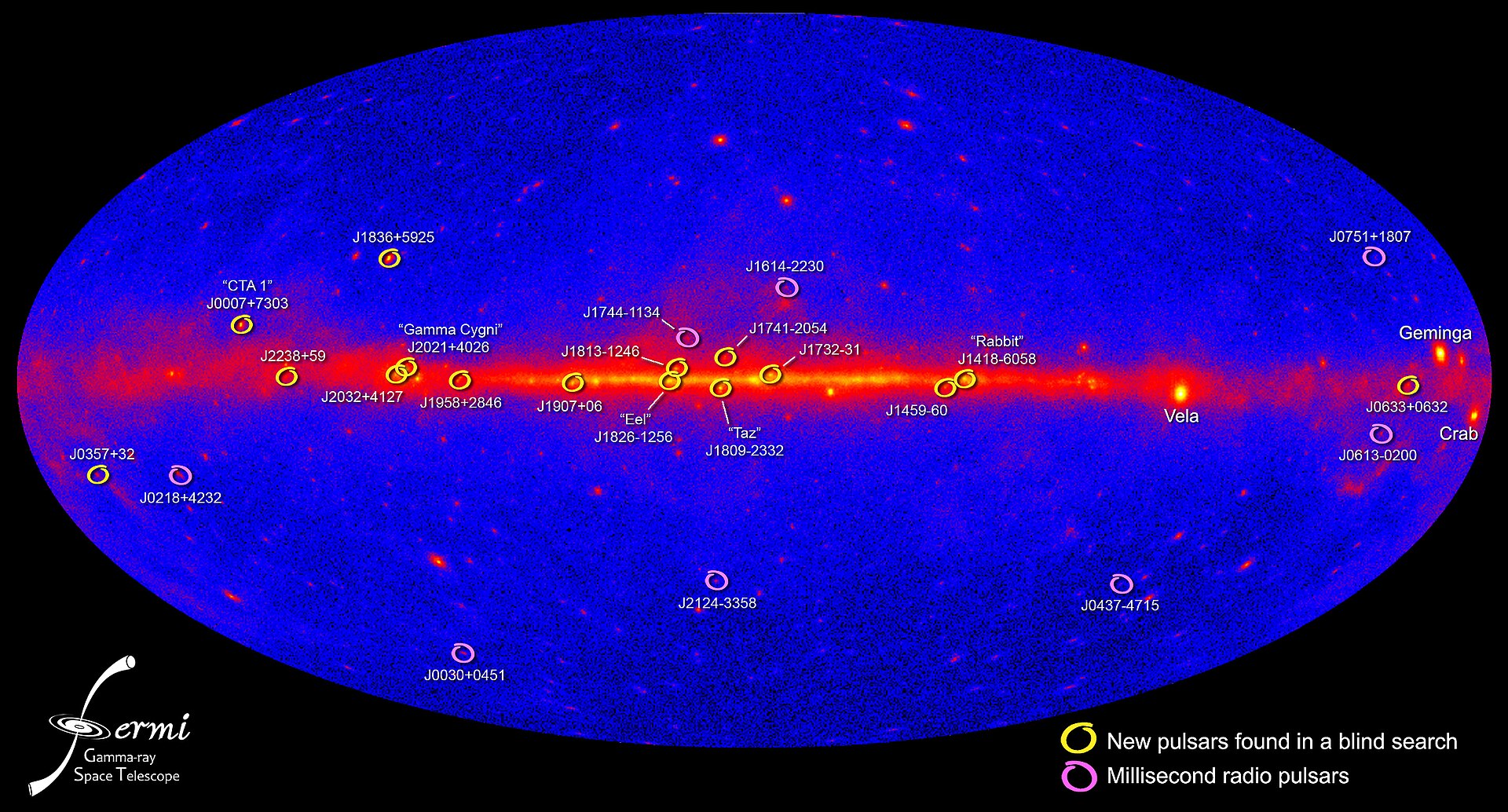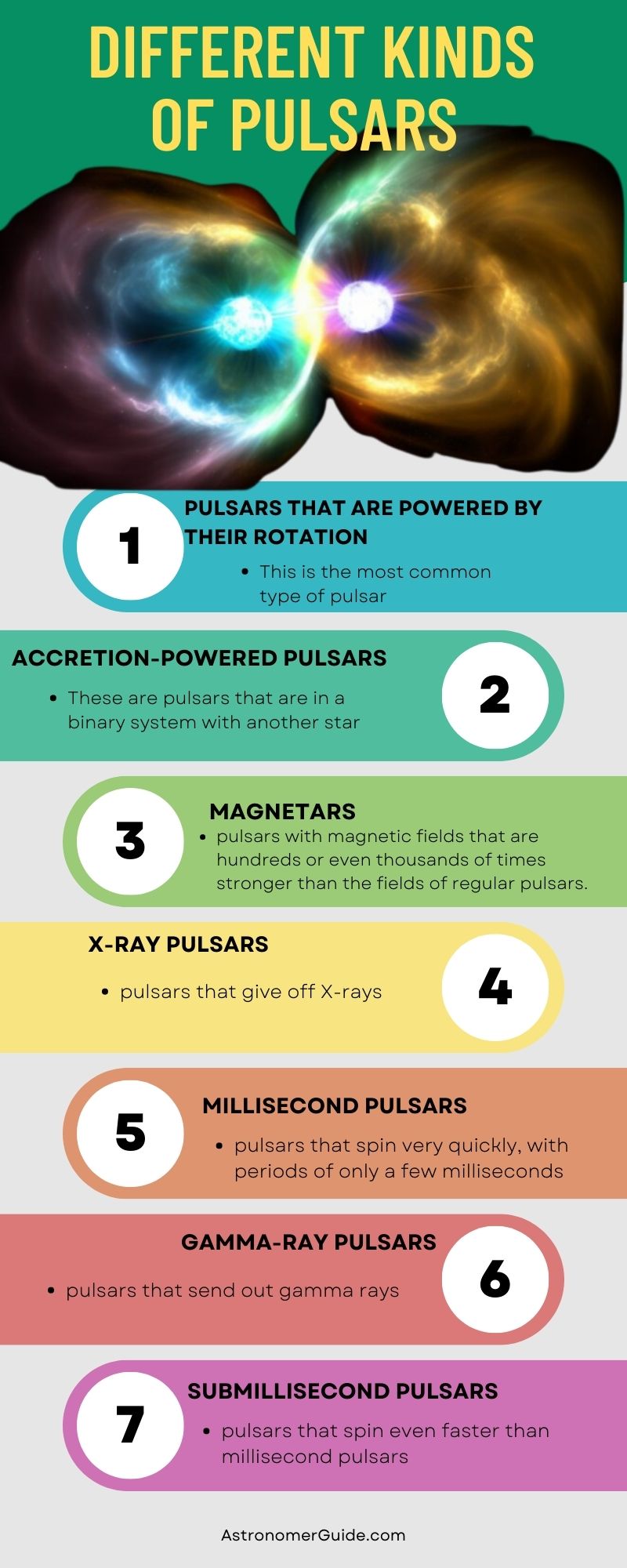Have you ever heard of pulsars? These cosmic lighthouses are some of the most mysterious and fascinating objects in the universe.
Pulsars are neutron stars that send out regular pulses of electromagnetic radiation like radio waves and gamma rays. They were first found in the 1960s. They are incredibly dense, spinning at breakneck speeds, and emit powerful magnetic fields that can influence their surroundings. In this article, we’ll try to figure out what pulsars are and what they mean for astronomy.
Contents
What are pulsars, and how do they form?

Pulsars are fast-spinning neutron stars, which are the collapsed cores of massive stars that have exploded as supernovae.
When a neutron star spins rapidly, it emits beams of radiation from its magnetic poles. These beams move through space like a lighthouse, sending out regular pulses of light and other forms of radiation that can be seen from Earth.
These neutron stars are incredibly dense, with a mass of around 1.4 times that of the sun packed into a sphere just 20 kilometers in diameter.
This means that a single teaspoon of neutron star material would weigh about 6 billion tons!
Neutron stars are also scorching and energetic, with temperatures that can reach millions of degrees and magnetic fields that can be trillions of times stronger than Earth’s.
Here are some fundamental properties and behaviors of pulsars:
- Pulsars spin rapidly, with periods ranging from milliseconds to several seconds. The fastest known pulsar, known as PSR J1748-2446ad, rotates at a rate of 43,000 revolutions per minute!
- Pulsars have powerful magnetic fields, which can accelerate particles to near the speed of light and create intense radiation.
- Pulsars can be observed across the electromagnetic spectrum, from radio waves to X-rays and gamma rays.
- Pulsars can exhibit complex behaviors, such as glitching (sudden changes in spin rate), drifting (changes in the shape and position of the pulse profile), and nulling (temporary cessation of pulsar emission).
How were pulsars discovered?
Pulsars were found for the first time in 1967 by Jocelyn Bell Burnell and Antony Hewish.
They were using a big radio telescope in England to study radio waves coming from the sky. They noticed a peculiar signal that repeated with incredible regularity, appearing like a series of pulses.
At first, they thought it might be a signal from an extraterrestrial civilization, but further observations revealed that it was coming from a rapidly spinning neutron star. They named it “LGM-1” for “Little Green Men” but later realized it was a pulsar.
Since then, thousands of pulsars have been discovered using radio telescopes, as well as other types of telescopes that can detect different forms of radiation.
Why are pulsars important?
Studying pulsars can help us understand matter’s properties. They have become important tools for studying the properties of matter under extreme conditions, testing theories of gravity, and even searching for gravitational waves.
Because pulsars are incredibly dense objects, with masses greater than the sun but compressed into spheres only a few miles in diameter. As a result, they provide a one-of-a-kind laboratory for studying the properties of matter under extreme conditions.
Scientists can learn about the behavior of matter at densities and pressures that are impossible to replicate on Earth by studying the behavior of pulsars.
Pulsars Can Aid Our Exploration of the Universe

Pulsars emit electromagnetic radiation beams that sweep across space and can be detected by telescopes on Earth. Scientists can learn about the structure and evolution of the universe by studying the properties of pulsars.
Pulsars can help us test Einstein’s General Theory of Relativity.
The presence of massive objects, according to Einstein’s theory of general relativity, can distort the fabric of space-time.
The regularity of their pulses can be used to detect any distortions in space-time caused by nearby massive objects, making pulses a unique opportunity to test this theory.
How many different kinds of pulsars exist?

There are different kinds of pulsars, which can be put into groups based on things like how they emit light, where they are, and how they came to be. Some of the most common kinds of pulsars are:
1. Pulsars that are powered by their rotation: This is the most common type of pulsar, and it is what gives them their energy. They send out beams of radiation from their magnetic poles. These beams create the pulsing signals that radio telescopes can pick up.
2. Accretion-powered pulsars: These are pulsars that are in a binary system with another star, and they get their power from the matter that falls in from the other star. As things fall onto the pulsar, the pulsar heats up and sends out X-rays.
3. Magnetars are pulsars with magnetic fields that are hundreds or even thousands of times stronger than the fields of regular pulsars. They send out bursts of high-energy radiation, such as X-rays and gamma rays.
4. X-ray pulsars: These are pulsars that give off X-rays. X-rays are made when matter from a companion star falls onto the pulsar.
5. Millisecond pulsars are pulsars that spin very quickly, with periods of only a few milliseconds. They are thought to be old pulsars that have grown because a nearby star has added to them.
Gamma-ray pulsars are pulsars that send out gamma rays, which are the form of electromagnetic radiation with the most energy. Gamma-ray telescopes, like the Fermi Gamma-ray Space Telescope, are used to find them.
7. Submillisecond pulsars are pulsars that spin even faster than millisecond pulsars, with periods of less than one millisecond. They are some of the fastest-spinning things in the universe, and scientists think they are very old pulsars that have been spun up by accretion or mergers.
These are just a few examples of the different kinds of pulsars that have been seen. Each type teaches us something different about the physics of extreme environments and how things behave when they are in those environments.
Where Are the Earth’s Closest Pulsars?
Astronomers have been examining the pulsars that are reasonably close to Earth for many years. Some of the pulsars closest to Earth are:
- PSR J0108-1431: This pulsar can be found in the constellation Cetus, around 280 light-years away from Earth. One of the oldest and nearest pulsars to Earth, it was found in 1990.
- Around 1,500 light-years from Earth, in the constellation Dorado, is the pulsar PSR J0437-4715. Due to its closeness to Earth, it was found in 1993 and is one of the pulsars that has been examined the most.
- PSR J1748-2446ad: This pulsar is situated in the constellation Sagittarius, roughly 9,000 light-years from Earth. One of the known pulsars spinning the fastest was found in 2005.
- This pulsar, designated PSR J1939+2134, is situated 3,600 light-years away from Earth in the constellation Vulpecula. It is one of the brightest pulsars known and was found in 2005.
FAQs about pulsars:
Q: What is the difference between a pulsar and a quasar?
A: A pulsar is a type of neutron star that emits regular pulses of radiation, while a quasar is a type of active galactic nucleus that emits massive amounts of radiation from a supermassive black hole.
Q: Can pulsars be seen with the naked eye?
A: No, pulsars are too faint to be seen with the naked eye. They can only be detected using telescopes that are sensitive to their radiation.
i.e., radio telescopes or telescopes that can detect gravitational waves like
Q: Do pulsars have planets?
A: Since today, the discovery of pulsar planets is limited to five, it is possible that pulsars even have habitable planets (theoretically).
Q. How many pulsars have been discovered so far?
A. As of 2023, over 3000 pulsars have been discovered.
The discovery of binary pulsars opens up new insights into gravity.
Binary pulsars are some of the most fascinating objects in the universe. They can consist of a combination of two pulsars, pulsar and white dwarf, or pulsar and neutron star that orbit around each other, creating a complex dance of gravity and radiation.

Here are some mind-blowing facts about binary pulsars that will leave you in awe:
- The first binary pulsar was discovered in 1974 by Russell Hulse and Joseph Taylor, Jr., for which they were awarded the Nobel Prize in Physics in 1993. The pulsar system, known as PSR B1913+16, consists of two neutron stars orbiting each other every 7.75 hours.
- Binary pulsars provide some of the most stringent tests of Einstein’s theory of general relativity. The pulsars’ orbits can be precisely measured, and any deviations from the predicted behavior can reveal new physics beyond Einstein’s theory.
- Binary pulsars can emit gravitational waves, which are ripples in the fabric of space-time predicted by Einstein’s theory of general relativity. These waves were first detected in 2015 by the Laser Interferometer Gravitational-Wave Observatory (LIGO), which observed two black holes merging.
- Binary pulsars can undergo complex orbital dynamics, such as precession, where the pulsars’ orbits slowly change orientation over time. This can be caused by the pulsars’ strong magnetic fields and the effects of general relativity.
- Binary pulsars can provide valuable information about the properties of neutron stars, which are some of the most extreme objects in the universe. By measuring the pulsars’ masses and radii, astronomers can test different models of neutron star structure and composition.
- Some binary pulsars exhibit bizarre behavior, such as “black widow” pulsars, where a rapidly spinning pulsar is gradually consuming its companion star. The pulsar emits intense radiation that can evaporate the companion’s outer layers, leaving behind a trail of gas.
- Binary pulsars can also exhibit “redback” behavior, where a pulsar is slowly eroding its companion star but not consuming it entirely. The pulsar emits intense radiation that can strip away the companion’s outer layers, leaving behind a highly compressed object known as a “black widow” pulsar.
- Binary pulsars can also be used as clocks that are more precise than atomic clocks. The pulsars emit regular pulses of radiation, which can be timed with incredible accuracy. This makes them useful for studying the behavior of gravitational waves, as well as for navigation in space.
Conclusion
In conclusion, binary pulsars are fascinating objects that provide valuable insights into the nature of gravity, the properties of neutron stars, and the behavior of complex systems in the universe. As astronomers continue to study these objects, we are sure to uncover even more mind-blowing facts and mysteries about the cosmos.


